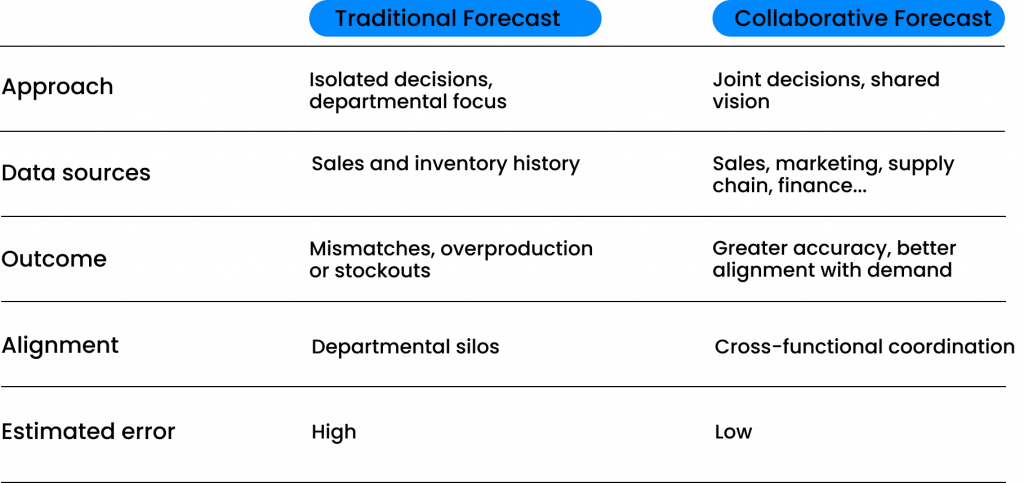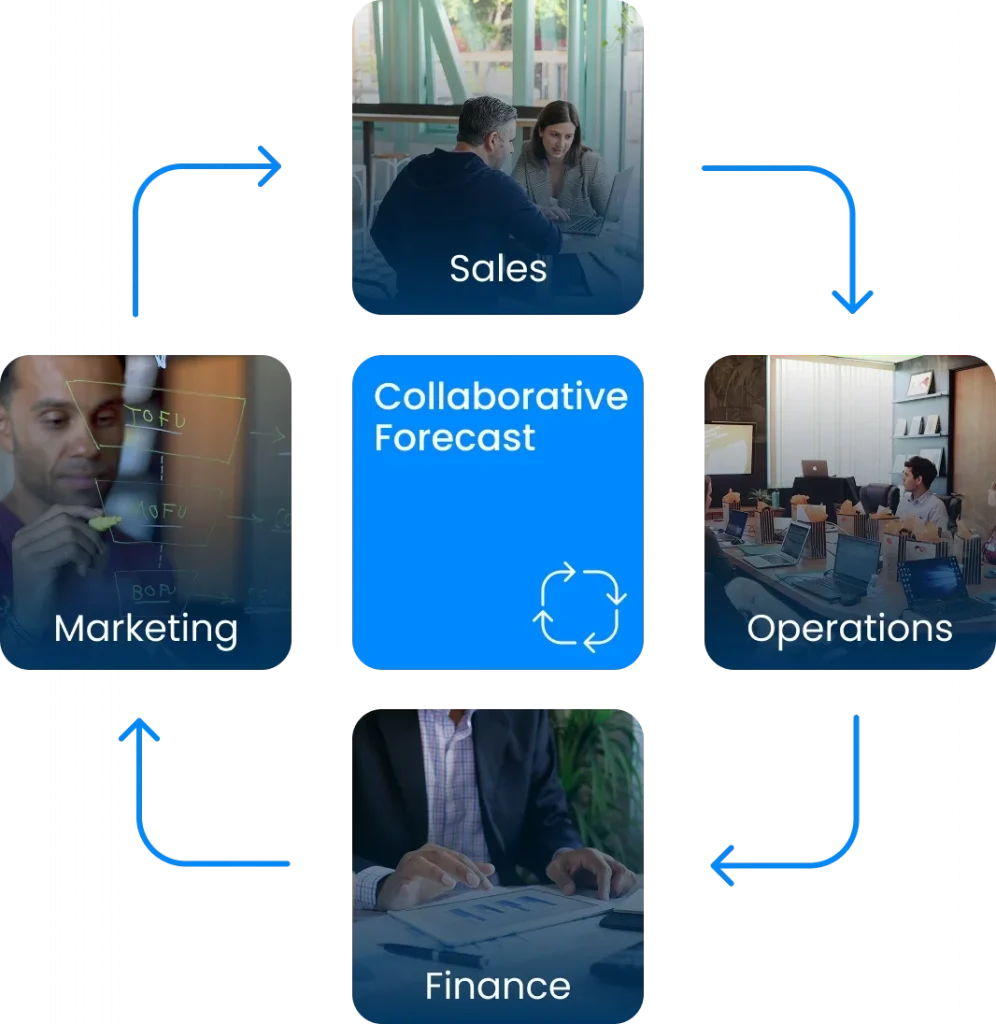Collaborative Forecasting: When Sales and Operations Are on the Same Page

In many organizations, demand forecasting remains a siloed, one-way process that often falls short. Sales teams use their own numbers, marketing builds plans separately, operations try to prepare with outdated or incomplete data, and finance sets goals based on disconnected assumptions. The result? Misalignment, friction, and decisions that don’t reflect what’s really happening in the market. Collaborative forecasting offers a structured, data-driven way to align all teams around a single, realistic forecast.
More than just a planning technique, it’s a cultural shift in how companies make decisions. In this post, we’ll explain what collaborative forecasting is, how to implement it effectively, the benefits it brings, and why it’s essential for companies looking to stay ahead of change.
What Is Collaborative Forecasting?
Collaborative forecasting is a demand planning method that brings together multiple business functions to create one shared forecast. It blends historical data with expert insights to deliver more accurate, actionable plans.
By tearing down information silos, it ensures that everyone in the value chain is aligned around a unified view of future demand, driving better coordination both strategically and operationally.
Collaborative Forecasting vs. Traditional Forecasting
Traditional forecasts typically sit within supply chain or planning departments, relying mostly on statistical models based on past sales. While fast and automated, this approach often ignores key insights from other teams, like new product launches, promos, channel shifts, or market trends.
Collaborative forecasting fixes that by combining data science with cross-functional input. Sales, marketing, finance, and ops all contribute, ensuring that forecasts reflect real-world business priorities, not just historical patterns.

Who Should Be Involved?
One of collaborative forecasting’s biggest strengths is how it brings departments together. Key players include:
- Sales: Adds front-line knowledge about deals, risks, accounts, and expectations.
- Marketing: Contributes insights tied to campaigns, launches, and brand initiatives.
- Operations: Translates demand into production, procurement, and logistics needs.
- Finance: Aligns plans with budgets and cash flow expectations.
- Leadership: Uses the shared forecast to make informed strategic calls.
How to Build a Strong Collaborative Forecasting
To make collaborative forecasting work, several elements must come together:
Clear Roles and Rich Data Sources
A solid collaborative forecast draws from both quantitative data (past sales, consumption patterns, trends) and qualitative inputs (market intelligence, sales activity, supplier/customer feedback).
Each team plays a specific role: sales and marketing adjust inputs based on field knowledge, operations validate feasibility, and finance ensures financial alignment.
Structured Workflows and Review Cycles
The process runs best with recurring reviews—monthly or bi-weekly, depending on market volatility. Each cycle typically includes:
- Reviewing prior forecasts and actual outcomes
- Adding new inputs (promos, cancellations, pricing changes)
- Reaching a consensus-based forecast
Documenting the process and versioning each iteration ensures accountability and transparency.
Recommended Digital Tools
Technology plays a key role in keeping collaboration smooth and consistent. Supply chain planning platforms should enable teams to:
- Consolidate and track inputs from all departments
- Visualize demand scenarios in real time
- Compare forecasted vs. actual results
- Automate reports and consistency checks
Modern Supply Chain Management software centralizes all of this in one place, making the process easier to scale and repeat.

Why Collaborative Forecasting Matters: Real Business Impact
Better Forecast Accuracy
By blending multiple viewpoints with data, collaborative forecasting reduces the errors caused by isolated planning. It’s especially useful for new SKUs, seasonal items, or markets with high variability.
Stronger Cross-Functional Alignment
A single forecast gets everyone on the same page. That means fewer misunderstandings, smoother execution, and faster decisions.
Direct Impact on Inventory, Production, and Service
More accurate demand plans mean better production scheduling, fewer stockouts or overstocks, and stronger service levels. Procurement and logistics also benefit from clearer visibility and better coordination.
When Should You Use Collaborative Forecasting?
While useful in most contexts, it’s especially valuable in:
Fast-Moving Product Lines
Industries like food, cosmetics, and retail, with frequent launches and short life cycles, need real-time collaboration to keep forecasts aligned.
Promotional or Seasonal Spikes
In sectors like fashion, toys, or FMCG, where promos and seasonality drive demand, collaborative planning helps smooth out peaks and reduce last-minute surprises.
Multi-Channel or Multi-Market Environments
For businesses selling across various channels (retail, DTC, B2B) or countries, coordinated input ensures a consistent, reliable forecast across the board.
How SCM Software Powers Real-Time Collaboration
SCM technology isn’t just helpful, it’s essential for making collaborative forecasting scalable, efficient, and reliable. Here’s how:
Integrated Data Streams
The right software pulls data automatically from your ERP, CRM, and sales platforms, minimizing manual work and errors while ensuring everyone works from the same source of truth.
Scenario Planning
Need to test the impact of a promotion or price hike? Scenario simulations help you explore different outcomes and make more agile decisions.
Version Control and Approval Workflows
Structured approvals define who submits forecasts, who reviews, and when versions are locked. This keeps the process accountable and fully traceable.
Collaborative Forecasting: Align, Anticipate, Act
Collaborative forecasting isn’t just about improving numbers; it’s about improving how your teams work together. It leads to better alignment, smarter decisions, and greater responsiveness. In fast-changing markets, it’s a true competitive edge.
At Imperia, we offer the technology and expertise to help you put collaborative forecasting into practice, making it part of your everyday operations. Ready to see the difference it can make? Book your free consultation today. Our experts are here to help.

Subscribe to our newsletter and transform your management!
Receive updates and valuable resources that will help you optimize your purchasing and procurement process.